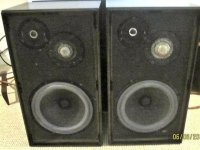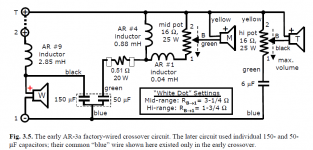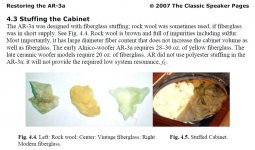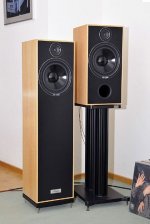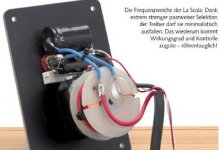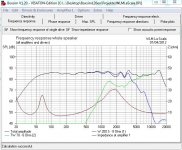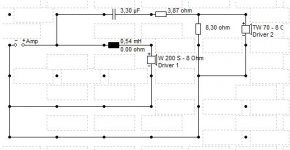Hyder Cone Products was the manufacturer who produced the legendary cones in many significant designs. Without them ?
LS3/5A Rogers' History
LS3/5A Rogers' History
At KEF we vacuum formed all our own bextrene cones, and some of the polypro cones. It isn't a high tech process.
Bextrene is great to vacuum form, warm it until it sags, then a little hotter and it goes taught, then hit the vacuum. Problem is it is extremly high Q and sounds horrible. That is why the units all have such a thick coating, for damping. The material was designed for plastic retail packaging. Poly pro has better internal damping with less weight, typically giving about 2 dB more sensitivity. Hard to glue to, though.
David
Bextrene is great to vacuum form, warm it until it sags, then a little hotter and it goes taught, then hit the vacuum. Problem is it is extremly high Q and sounds horrible. That is why the units all have such a thick coating, for damping. The material was designed for plastic retail packaging. Poly pro has better internal damping with less weight, typically giving about 2 dB more sensitivity. Hard to glue to, though.
David
speaker dave, you never fail to surprise me. As well as being a bit knowledgeable about the AR-4X (Tell us about acoustic suspension! I never quite get why it is different from closed box!), you worked at KEF. You don't by any chance remember what the voice coil inductance of a KEF B200 SP1193 cardboard cone is, do you? 
Back on topic. There is much to admire and enjoy in the Spendor Classic Range, including a fifth model which is an update of the BBC LS3/5A. Spendor seem to have plastic cones reaching higher frequencies these days, and phase plugs are now standard too. They only use bextrene on the 12" bass these days, the rest are something like polypropylene. I like the second one with the two tweeters. The middle tweeter has a copper pole piece, which is supposed to improve linearity.
I visited Chartwell's Mitcham factory in the seventies to get my PM400 tweeters fixed, so maybe saw a Hyder Cone machine. Met some good engineers and cabinet builders there. As I think I mentioned, the Dalesford 12" based drivers tend to sag and rub voice coils, but the thing I have always noticed about plastic cones is they do flat frequency response with lower inductance than any other design, which is what is good about them. This makes crossovers easier.
An externally hosted image should be here but it was not working when we last tested it.
Back on topic. There is much to admire and enjoy in the Spendor Classic Range, including a fifth model which is an update of the BBC LS3/5A. Spendor seem to have plastic cones reaching higher frequencies these days, and phase plugs are now standard too. They only use bextrene on the 12" bass these days, the rest are something like polypropylene. I like the second one with the two tweeters. The middle tweeter has a copper pole piece, which is supposed to improve linearity.
An externally hosted image should be here but it was not working when we last tested it.
I visited Chartwell's Mitcham factory in the seventies to get my PM400 tweeters fixed, so maybe saw a Hyder Cone machine. Met some good engineers and cabinet builders there. As I think I mentioned, the Dalesford 12" based drivers tend to sag and rub voice coils, but the thing I have always noticed about plastic cones is they do flat frequency response with lower inductance than any other design, which is what is good about them. This makes crossovers easier.
An externally hosted image should be here but it was not working when we last tested it.
"Tell us about acoustic suspension! I never quite get why it is different from closed box!"
An acoustic suspension speaker is a closed box design but it is only one type of closed box design. Another is an infinite baffle. To those accostomed to thinking in terms of Thiel Small parameters for speaker design, that is a cookbook recipe for applying Newton's second law of motion as applied to forced oscillation. This can be found in any college physics textbook and applies to many kinds of problems including explaining how woofer/enclosures work. In brief, an acoustic suspension system incorporates a woofer which largely uses the difference between the pressure of air trapped inside the box and the air outside the box to restore the cone when it is displaced. When it moves in the air inside is compressed and pushes back out. When it moves out, the air inside is rarified and pulls it back in. The stuffing inside the box has small spaces between the fibers the speaker pushes and pulls air through creating aerodynamic drag. This dampens the speaker's resonance. By adjusting the system for the moving mass, the drag of the stuffing and the volume of air, in principle any acoustic suspension speaker can be tuned to any desired resonant frequency with any desired system Q. The granddaddy of AS designs and basically the same woofer design used in all of the company's TOTL speakers from the mid 1950s to the mid 1980s is the 12" Acoustic Research AR1W. There are other advantages to the design such as the restoring force being applied uniformly over the cone unlike mechanical suspension speakers. This reduces the tendency of the cone to break up into harmonic modes. The design also has only a 12 db per octave falloff below resonance so within the speaker's power handling and maximum excursion the FR can be extended an octave or more below system resonance (ported designs with a 24 db per octave falloff cannot be extended that way.) AR4 series and similar was a low cost variant using an 8" acoustic suspension woofer in a two way design. AR2 series was an intermediate cost variant using a 10" woofer. AR 12" systems can still hold their own in bass response against many expensive contemporary speakers. Teledyne AR9 which uses 2 side firing 12" AS drivers in a double sized enclosure can produce bass that will likely outperform most speakers on the market today regardless of price.
An acoustic suspension speaker is a closed box design but it is only one type of closed box design. Another is an infinite baffle. To those accostomed to thinking in terms of Thiel Small parameters for speaker design, that is a cookbook recipe for applying Newton's second law of motion as applied to forced oscillation. This can be found in any college physics textbook and applies to many kinds of problems including explaining how woofer/enclosures work. In brief, an acoustic suspension system incorporates a woofer which largely uses the difference between the pressure of air trapped inside the box and the air outside the box to restore the cone when it is displaced. When it moves in the air inside is compressed and pushes back out. When it moves out, the air inside is rarified and pulls it back in. The stuffing inside the box has small spaces between the fibers the speaker pushes and pulls air through creating aerodynamic drag. This dampens the speaker's resonance. By adjusting the system for the moving mass, the drag of the stuffing and the volume of air, in principle any acoustic suspension speaker can be tuned to any desired resonant frequency with any desired system Q. The granddaddy of AS designs and basically the same woofer design used in all of the company's TOTL speakers from the mid 1950s to the mid 1980s is the 12" Acoustic Research AR1W. There are other advantages to the design such as the restoring force being applied uniformly over the cone unlike mechanical suspension speakers. This reduces the tendency of the cone to break up into harmonic modes. The design also has only a 12 db per octave falloff below resonance so within the speaker's power handling and maximum excursion the FR can be extended an octave or more below system resonance (ported designs with a 24 db per octave falloff cannot be extended that way.) AR4 series and similar was a low cost variant using an 8" acoustic suspension woofer in a two way design. AR2 series was an intermediate cost variant using a 10" woofer. AR 12" systems can still hold their own in bass response against many expensive contemporary speakers. Teledyne AR9 which uses 2 side firing 12" AS drivers in a double sized enclosure can produce bass that will likely outperform most speakers on the market today regardless of price.
That's a flipping EXCELLENT explanation, Soundminded. So it's mostly in the stuffing that you'll see the difference over closed box! Makes sense. 
I did know AR used high inductance and long voice coils, along with heavy cones with low Qts around 0.3 and foamed surrounds. And simple crossovers. http://www.classicspeakerpages.net/
Here's the AR-3A:
Always liked them, though they sounded best in a VERY big room.
I did know AR used high inductance and long voice coils, along with heavy cones with low Qts around 0.3 and foamed surrounds. And simple crossovers. http://www.classicspeakerpages.net/
Here's the AR-3A:
An externally hosted image should be here but it was not working when we last tested it.
Always liked them, though they sounded best in a VERY big room.

Attachments
speaker dave, you never fail to surprise me. As well as being a bit knowledgeable about the AR-4X (Tell us about acoustic suspension! I never quite get why it is different from closed box!), you worked at KEF. You don't by any chance remember what the voice coil inductance of a KEF B200 SP1193 cardboard cone is, do you?
Hi System 7,
I don't have any details on the 1193 but you might try the guys at the KEF forum. Speaker Guru worked there about a decade longer than I did and remembers a lot of details.
SpeakerTalk :: View Forum - KEF Speakers from the 1970s
From the look of it it might have been one of the budget units that we bought from Elac rather than building in house (Elac UK, not ELAC Germany). I wouldn't think in terms of inductance anyway because you can't properly give an inductance number to VC impedance. Driver impedance rises at a slow rate due to loose coupling to the core pole so the inductance measured would vary greatly with different measurement frequencies.
Regarding "acoustic suspension", this is a fairly nebulous term and is really just one end of the spectrum of all closed box designs. Anything with an alpha of 3 or greater is usually termed AS, while alpha less than that is approaching "infinite baffle". They all share the same acoustic model.
As an explanation, alpha is the ratio of box stiffness to woofer stiffness (also = woofer Vas divided by V box). If box stiffness is 3 times woofer stiffness (or more) then it is a relatively small box and free air resonance will rise considerably when enclose with the cabinet providing most of the restoring force.
2 assides: increasing the woofer compliance is not what was unique about the AR1W. The bigger difference from the contemporary systems was the high woofer mass used. High compliance alone (indeed, even infinite compliance) would not have retained low resonance in that size box. Vilchur piled on the mass to get the final system Q to a value that gave flat bass rather than maximum midband sensitivity. Recent 50 watt tube amps allowed him to do that.
Secondly, Vilchur was preceeded by Olson and Preston of RCA who patented the Acoustic Suspension approach 5 years before.
Huh...?
David
What characterizes an acoustic suspension speaker is that most of the restoring force on the cone is the result of differential air pressure between the inside and outside of the enclosure, not the mechanical stiffness of the suspension. Acoustic suspension speakers are therefore loosely suspended by intent, the first ones using cloth instead of foam. There would be no necessity for any mechanical stiffness whatsoever were it not for the manometric effect, that is the neutral point changing with external barometric pressure. In fact a very small amout of air is allowed to leak between the inside and outside and about 10% of the restoring force comes from the mechanical stiffness of the suspension. Ideally the enclosure is entirely rigid and air tight.
AS drivers are not only characterized by very high compliance suspensions but heavy cones. This is how the mass spring dashpot system defined by the driver and enclosure including the stuffing is tuned according to Newton's second law or more conventionally by TS paramerers. An AR 12" woofer has a free air resonance in the vacinity of 16 to 18 hz and the system has an F3 of around 35 hz. It can easily be electrically equalized flat to 20 hz and only has about 5% THD at moderate levels at very low frequencies. Teledyne AR9 with two 12" woofers in a double sized box does even better with an F3 of 28 hz and can be equalized flat to below audibility without significant distortion. The result is the capability for wall shaking window rattling gut wrenching bass if the input signal contains very low frequencies.
Most people familiar with Villchur's invention do not consider that Olson's speaker was in any way comparable. It hardly matters. AR garnered more praise and a larger share of the speaker market in its heyday than any other speaker manufacturer. AR3 is on exhibit in the Smithsonian Institution as an example of excellence in American manufacturing and engineering. AR3 and AR3a were considered the reference standards regardless of size or cost by many professional musicians, record collectors, and laboratories in their heyday.
AS drivers are not only characterized by very high compliance suspensions but heavy cones. This is how the mass spring dashpot system defined by the driver and enclosure including the stuffing is tuned according to Newton's second law or more conventionally by TS paramerers. An AR 12" woofer has a free air resonance in the vacinity of 16 to 18 hz and the system has an F3 of around 35 hz. It can easily be electrically equalized flat to 20 hz and only has about 5% THD at moderate levels at very low frequencies. Teledyne AR9 with two 12" woofers in a double sized box does even better with an F3 of 28 hz and can be equalized flat to below audibility without significant distortion. The result is the capability for wall shaking window rattling gut wrenching bass if the input signal contains very low frequencies.
Most people familiar with Villchur's invention do not consider that Olson's speaker was in any way comparable. It hardly matters. AR garnered more praise and a larger share of the speaker market in its heyday than any other speaker manufacturer. AR3 is on exhibit in the Smithsonian Institution as an example of excellence in American manufacturing and engineering. AR3 and AR3a were considered the reference standards regardless of size or cost by many professional musicians, record collectors, and laboratories in their heyday.
I recently sent an email to Dennis Jaeger who was the U.S.A. Dalesford distributor back in 1980. He also sold some of the Fried kits marketed under the name of Sonkits. He had very little info on any of the drivers. He wrote that the companies specs not being very reliable. The Dalesford Rogers oem drivers as well as the Fried oem drivers had a much higher sensitivity then any of the Kef and Audax bextrene.cones. This was achieved by using a thinner cone compared to the Audax or Kef drivers. The Audax HD17B37R2C12and HD21B37R2C12 measure 6-8db lower for the same input compared to my Fried Dalesford drivers. A sensitivity of 89db for a D153 about the same of many modern drivers. The tonal character quite different then the stock versions having a voice inductance of .5mh.
The history is interesting of the development of the drivers.
There was a Rogers dealer in my area in the 1980's.
We compared the Ls3/5a to our Fried Model C at the store and the owner almost threw us out.
The history is interesting of the development of the drivers.
There was a Rogers dealer in my area in the 1980's.
We compared the Ls3/5a to our Fried Model C at the store and the owner almost threw us out.
I enjoyed reading that history of Rogers, Mr. Jim. Amazing it was all done on such a small operation...6 people at heart! 
Sorry to hear my MA KEF driver is a bit, er, cheapish.
This won't do. Here's my new plan. I'm going to build the 22L reflex monitor version of the WLM La Scala!
6moons audio reviews: WLM La Scala
This baby uses the Visaton W200 S bass and TW70 cone tweeter.
Visaton - Lautsprecher und Zubehör, Loudspeakers and Accessories
Visaton - Lautsprecher und Zubehör, Loudspeakers and Accessories
We had a look at it in the notorious fractious series crossover thread, of course. Decided the crossover was a simple one, second order bass, first order tweeter with an AR type attenuator thrown in:
This some design, by all accounts. Ought to sound lively like an Acoustic Research AR-4X, I reckon. Only better.
Sorry to hear my MA KEF driver is a bit, er, cheapish.
This won't do. Here's my new plan. I'm going to build the 22L reflex monitor version of the WLM La Scala!
An externally hosted image should be here but it was not working when we last tested it.
6moons audio reviews: WLM La Scala
This baby uses the Visaton W200 S bass and TW70 cone tweeter.
Visaton - Lautsprecher und Zubehör, Loudspeakers and Accessories
Visaton - Lautsprecher und Zubehör, Loudspeakers and Accessories
We had a look at it in the notorious fractious series crossover thread, of course. Decided the crossover was a simple one, second order bass, first order tweeter with an AR type attenuator thrown in:
An externally hosted image should be here but it was not working when we last tested it.
This some design, by all accounts. Ought to sound lively like an Acoustic Research AR-4X, I reckon. Only better.

Attachments
I would never put down the Kef drivers. I do make observations. I stated on the ARIEL THREAD about the article comparing drivers in a t-line. I was surprised the Audax 5" bextrene tested had a qts. of .16. The Audax bextrene cones all had paper voice coil formers. Most of the Kef B110's had a wide variation in specs according to Gary Galo
I think it was one reason so many of them made their way to the Constructor Kits sold by Madisound.
I would have purchased a Rogers Ls6 if they were available in kit form.
If a Kef B110 was used in a t-line I would think the crossover would have to be changed for the response change due to the enclosure type. The defunct Speakermania message board had a few people I found that used in them in t-lines with excellent results.
I think it is quite interesting Spendor still use a bextrene 12'.
Jerry at Falcon informed me plastiflex is no longer produced in the U.K.
I wonder what is being used to damp many of the paper cone drivers now?
I never heard any of the Visation drivers. Quite interesting cone tweeter.
I wish I could hear some of the Monacor carbon fiber drivers as well. I wonder if they would tell System7 what the damping compound ingredients are? I would like to know. What does Vifa use to coat their paper cones?
I did not know Speaker Dave once worked at Kent Engineering Foundry.
I have posted on Speaker Talk forum trying to find more info on some of my old drivers.
Much debate to this day about European versions being far different then USA versions.
Most of the old timers have passed away that knew the inner workings of each companies developmental evolution.
The owner of Millersound who use to repair damaged Rogers drivers told me the copper voice coils could take more current then the aluminum voice coils of the Dynaudio driver line. Copper melts at a higher temperature then aluminum.
I think it was one reason so many of them made their way to the Constructor Kits sold by Madisound.
I would have purchased a Rogers Ls6 if they were available in kit form.
If a Kef B110 was used in a t-line I would think the crossover would have to be changed for the response change due to the enclosure type. The defunct Speakermania message board had a few people I found that used in them in t-lines with excellent results.
I think it is quite interesting Spendor still use a bextrene 12'.
Jerry at Falcon informed me plastiflex is no longer produced in the U.K.
I wonder what is being used to damp many of the paper cone drivers now?
I never heard any of the Visation drivers. Quite interesting cone tweeter.
I wish I could hear some of the Monacor carbon fiber drivers as well. I wonder if they would tell System7 what the damping compound ingredients are? I would like to know. What does Vifa use to coat their paper cones?
I did not know Speaker Dave once worked at Kent Engineering Foundry.
I have posted on Speaker Talk forum trying to find more info on some of my old drivers.
Much debate to this day about European versions being far different then USA versions.
Most of the old timers have passed away that knew the inner workings of each companies developmental evolution.
The owner of Millersound who use to repair damaged Rogers drivers told me the copper voice coils could take more current then the aluminum voice coils of the Dynaudio driver line. Copper melts at a higher temperature then aluminum.
I enjoyed reading that history of Rogers, Mr. Jim. Amazing it was all done on such a small operation...6 people
I did too, There was a lot in there I didn't know, & made me want a pair of 3/5A's but was it ever finished? Was there ever an end to the story?
It was also notable that just keeping the company (Rogers) afloat was a problem. The local rates bill saw them into receivership at one time. Taxes and rent is what kills a lot of little companies. 
My WLM La Scala's are progressing in the modelling stage, but it's looking more and more like an AR-4x style first order crossover to me, and the little black thing must be a poly switch fuse:
The 0.17mH tweeter is a bit of a beast to get flat, and the awkward 2.2mH woofer doesn't like second order at all! Any tips appreciated here.
Visaton give away a nice simulator called BoxSim with all the driver files, so having lots of fun simming it. I think I could be the new sreten!
Visaton - Lautsprecher und Zubehör, Loudspeakers and Accessories
An externally hosted image should be here but it was not working when we last tested it.
My WLM La Scala's are progressing in the modelling stage, but it's looking more and more like an AR-4x style first order crossover to me, and the little black thing must be a poly switch fuse:
An externally hosted image should be here but it was not working when we last tested it.
The 0.17mH tweeter is a bit of a beast to get flat, and the awkward 2.2mH woofer doesn't like second order at all! Any tips appreciated here.
An externally hosted image should be here but it was not working when we last tested it.
Visaton give away a nice simulator called BoxSim with all the driver files, so having lots of fun simming it. I think I could be the new sreten!
Visaton - Lautsprecher und Zubehör, Loudspeakers and Accessories
A bit geeky this one....
In days of yore two way speakers were subject to purchase tax, Considered domestic items. Three way designs used to be all expensive specialist designs, they were automatically considered professional monitors and therefore exempt from tax. Spendor therefore "needed" to extend the treble of their finely honed two way BC1 with a third driver for the BBC.
The BBC said that it was useful for detecting the high frequency whine from the scan frequency from line breakthrough on interlaced tube/CRT displays. About 15khz. So now we have supertweeters.
In days of yore two way speakers were subject to purchase tax, Considered domestic items. Three way designs used to be all expensive specialist designs, they were automatically considered professional monitors and therefore exempt from tax. Spendor therefore "needed" to extend the treble of their finely honed two way BC1 with a third driver for the BBC.
The BBC said that it was useful for detecting the high frequency whine from the scan frequency from line breakthrough on interlaced tube/CRT displays. About 15khz. So now we have supertweeters.
System7 the peak is going to be a challenge. That tweeter does look like a beast. One of each forum member is enough. I wonder if there are any twins on the forum?
Very little experience with cone tweeters in that league.
I am amazed the Rogers company had such a small number of employees to fill all their orders.
Very little experience with cone tweeters in that league.
I am amazed the Rogers company had such a small number of employees to fill all their orders.
System7 I never had to use one but a cap , inductor, resistor all in parallel of each other in series with the tweeter.
R
C-------------------------- + Tweeter
L
Jon_Risch's Web Site
This should have been added to the series thread.
I hope this helps flatten things out. Have you ever listened to the La Scala's?
R
C-------------------------- + Tweeter
L
Jon_Risch's Web Site
This should have been added to the series thread.
I hope this helps flatten things out. Have you ever listened to the La Scala's?
An externally hosted image should be here but it was not working when we last tested it.
That's an Isophon tweeter isn't it?
I did too, There was a lot in there I didn't know, & made me want a pair of 3/5A's but was it ever finished? Was there ever an end to the story?
Well, since my Rogers LS7T speakers have polypropylene cones, and I've seen Harbeth HL1 and HL2 speakers with "Swisstone Engineering" cast into the woofer baskets, I think it's easy to see where his story is heading.
You have a quite amazing eye for detail, Mr.dB. Almost worrying...
I had to remind myself what they were, but yes, Isophon KK10/8 to be exact.
The trick, IIRC, was to fit an aftermarket metal mounting plate to those cheapie plastic covers. Mine were yellowish transparent plastic domes, as it goes. You could see the BAF wadding behind the dome.
The system7 "Pagliacci" speakers (named with delicious irony, I hope you'll agree...) are simming along nicely since I discovered the optimise button in BoxSim. Really, what is hard about designing speakers? Money for old rope if you ask me!
I had to remind myself what they were, but yes, Isophon KK10/8 to be exact.
An externally hosted image should be here but it was not working when we last tested it.
The trick, IIRC, was to fit an aftermarket metal mounting plate to those cheapie plastic covers. Mine were yellowish transparent plastic domes, as it goes. You could see the BAF wadding behind the dome.
The system7 "Pagliacci" speakers (named with delicious irony, I hope you'll agree...) are simming along nicely since I discovered the optimise button in BoxSim. Really, what is hard about designing speakers? Money for old rope if you ask me!
An externally hosted image should be here but it was not working when we last tested it.
Attachments
- Home
- Loudspeakers
- Multi-Way
- Classic monitor designs?
